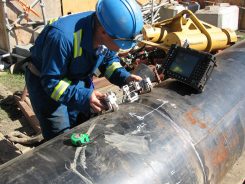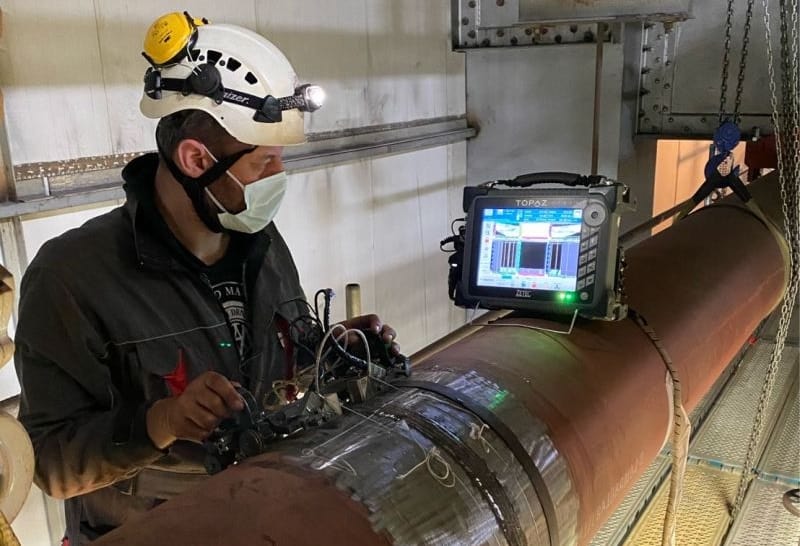Comprehensive Review of Pipe Welding Assessment Procedures
In the world of pipe building, making certain the integrity and security of welded joints is vital. Pipeline welding inspection treatments play a crucial duty in assuring that bonded links meet rigorous industry criteria and specs. From thorough pre-welding evaluations to thorough post-weld assessments, a distinct assessment procedure is vital for preserving the architectural soundness of pipes. Understanding the details of welding assessment procedures is not just a governing requirement yet also an essential facet of maintaining the reliability of these essential frameworks.
Pre-welding Assessment Preparations
Before commencing the welding procedure, comprehensive pre-welding evaluation prep work are necessary to make sure the stability and high quality of the weld joint. These preparations entail a thorough assessment of the materials to be welded, the welding tools, and the workplace. The products need to be checked for any kind of defects, impurities, or disparities that might jeopardize the weld. This consists of monitoring for proper material qualities, dimensions, and surface area problems. Pipeline Welding Inspection. Furthermore, the welding devices requires to be checked to confirm that it remains in great working condition, calibrated properly, and ideal for the certain welding procedure. Any type of concerns with the devices ought to be addressed immediately to stop defects in the weld. The work atmosphere need to be evaluated for cleanliness, appropriate ventilation, and safety and security steps to ensure a helpful setting for the welding operation. By conducting extensive pre-welding examination preparations, potential issues can be recognized and solved at an early stage, resulting in trustworthy and top notch weld joints.
Welding Procedure Credentials
Comprehensive pre-welding evaluation preparations lay the foundation for the critical process of Welding Treatment Qualification, guaranteeing the stability and quality of the weld joint. Welding Treatment Certification (WPQ) is an important step in the welding procedure that involves screening and licensing welding treatments to ensure they satisfy particular requirements and requirements. The WPQ procedure typically includes welding treatment specification advancement, welding procedure credentials screening, and paperwork of the outcomes.
During welding treatment spec development, crucial details such as the welding procedure, welding materials, joint design, and welding parameters are specified to create a comprehensive procedure. Consequently, welding treatment credentials screening is conducted to validate the proposed treatment's honesty. This testing commonly involves welding test vouchers that undergo various mechanical and non-destructive tests to analyze the weld's high quality and adherence to the specified standards.
In-process Weld Assessment
During the welding procedure, in-process weld inspection plays a vital role in ensuring the top quality and honesty of the weld joint - Pipeline Welding Inspection. This kind of evaluation entails keeping track of the welding parameters, assessing the weld grain formation, and discovering any prospective issues or suspensions as they occur. By conducting in-process weld examinations, welding operators can immediately attend to any kind of concerns that might emerge, therefore making sure and protecting against more flaws that the final weld meets the called for specifications
Typical techniques made use of for in-process weld examination include visual evaluation, liquid penetrant screening, magnetic particle screening, ultrasonic testing, webpage and radiographic screening. On the whole, in-process weld examination is crucial for preserving the top quality and integrity of bonded pipelines.
Non-destructive Screening (NDT)
Non-destructive Testing (NDT) is an important method utilized in pipeline welding inspection to assess the stability of weld joints without creating damage to the welded structure. By making use of various NDT strategies, examiners can assess the high quality of welds and determine any type of defects or discontinuities that might jeopardize the architectural strength of the pipeline. Typical NDT techniques made use of in pipeline welding examination consist of Radiographic Testing (RT), Ultrasonic Screening (UT), Magnetic Particle Examining (MPT), Fluid Penetrant Testing (LPT), and Visual Screening (VT)
RT entails using X-rays or gamma rays to create photos of the internal framework of the weld, allowing inspectors to find problems such as porosity, cracks, or insufficient combination. UT uses high-frequency audio waves to find flaws underneath the surface area of the weld, providing detailed information about the size and area of defects. MPT and LPT are used to identify surface-breaking problems by applying penetrant fluids or magnetic bits to the weld location. In addition, VT entails visual assessment of welds to identify any noticeable blemishes.
Post-weld Inspection and Documents

Documentation of post-weld inspection findings is essential for keeping quality assurance documents and making certain conformity with sector standards and guidelines. Detailed records ought to consist of information about the inspection techniques made use of, the area and nature of any problems located, and any rehabilitative activities taken - Pipeline Welding Inspection. Appropriate documents not just serves as a document of the weld's high quality but also help in future maintenance and examination processes
Verdict

Finally, pipe welding examination procedures play a critical role in making certain the quality and stability of welds. From pre-welding examinations to post-weld documentation, each action is important in keeping the safety and security and effectiveness of pipelines. By complying with well established treatments and carrying out extensive inspections, potential problems can be identified and addressed before they cause costly repair work or failures. On the whole, adherence to appropriate inspection protocols is essential to the success of pipe welding jobs.
From precise pre-welding inspections to extensive post-weld assessments, a distinct examination procedure is necessary for keeping the architectural strength of pipes. By conducting in-process weld inspections, welding operators can promptly deal with any kind of concerns that might emerge, consequently avoiding more issues and making sure that our website the final weld satisfies the needed specs.
Typical approaches utilized for in-process weld assessment consist of visual assessment, liquid penetrant testing, magnetic bit screening, ultrasonic testing, and radiographic testing.Non-destructive Testing (NDT) is a critical technique employed Discover More Here in pipe welding examination to examine the honesty of weld joints without triggering damage to the bonded framework. Post-weld inspection includes numerous approaches to examine the welds for problems, consisting of aesthetic examination, dye penetrant testing, magnetic particle testing, ultrasonic screening, and radiographic testing.